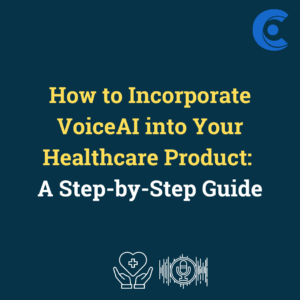How to Incorporate VoiceAI into Your Healthcare Product: A Step-by-Step Guide

Step 1: Identify Use Cases
Identifying use cases is the first step in incorporating VoiceAI into your healthcare product. It involves understanding users’ specific challenges and how VoiceAI can address them. For example, VoiceAI can improve patient engagement by providing personalized recommendations, reminding patients of medication schedules, and helping patients navigate complex healthcare systems.
Step 2: Determine User Needs
Once you have identified use cases for VoiceAI, the next step is determining user needs. Understand the unique requirements and preferences of your target audience. For example, some users prefer to interact with a virtual assistant through voice commands, while others prefer to use a touchscreen interface.
Step 3: Choose a Voice Platform
After identifying use cases and determining user needs, the next step is to choose a voice platform. Many voice platforms, including Amazon Alexa, Google Assistant, and Microsoft Cortana, are available. Each platform has strengths and weaknesses, so choosing the one that fits your needs is prudent.
Step 4: Develop Voice-enabled Features
Once you have chosen a voice platform, developing voice-enabled features is next. Create a conversational user interface that can understand natural language and respond accordingly to the user. For example, you may develop a virtual assistant to provide medical advice, schedule appointments, or answer common healthcare-related questions.
Step 5: Test and Refine
Once you have developed voice-enabled features, the next step is to test and refine your product. Conduct user testing to ensure that your VoiceAI product addresses the needs of your target audience. You may also need to refine your product based on user feedback and make adjustments to improve the overall user experience.
Step 6: Deploy and Monitor
Once you have completed testing and refinement, the final step is to deploy your product and monitor its performance. Track user engagement and usage metrics to understand how users interact with your product. You may also need to make ongoing improvements based on user feedback and changing market conditions.
Step 7: Ensure Compliance with Healthcare Regulations
It is essential to use secure servers, implement user authentication, encrypt data, conduct regular risk assessments, and have a business associate agreement with third-party vendors.
Step 8 – Train the End-User
It is crucial to train end-users on how to use the product effectively. Provide clear instructions, tutorials, and support to ensure users can fully benefit from the features and functionalities of the VoiceAI product.
